Making the Most of Your Mile: The Magnificent Mile
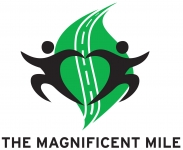
Presented by HOKA ONE ONE, the interview series speaks with Sarah Witt, Magnificent Mile founder and race director, on an event that is accessible and fun for all.
By Bring Back the Mile
The Magnificent Mile is entering its ninth year in Raleigh, North Carolina and paved the way for other great Miles that have been created in just the last two years, including the indoor track Camel City Mile in Winston-Salem as well as the Sir Walter Miler that occurred a few weeks ago in Raleigh. Home to the great Jim Beatty, who was the first person in history break 4 minutes in the Mile indoors, the Tar Heel State is truly bringing back the Mile.
Sarah Witt set out to create an accessible and fun event for everyone growing the event from just under 100 in year one to 1,200 last year. The Magnificent Mile, a BBTM Featured Event, is Sunday, September 14 in downtown Raleigh.
BBTM: You started the Magnificent Mile in 2006 as a response to having been diagnosed with a motor neuron disease and to raise awareness for it. Why the Mile?
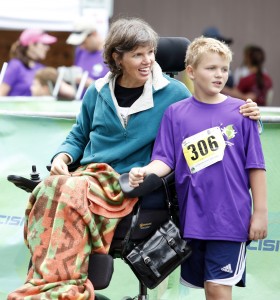 Sarah: In 2004, I started having neurological problems, but prior to that I had been a life-long runner. I ran the first few years of college and ran high school track and cross country; it was a big part of my life. By 2005, I had been diagnosed with a rare motor neuron disease called Primary Lateral Sclerosis (learn more here). I decided to start the Magnificient Mile in 2006 to raise awareness and also to keep myself involved in the running community. It has taken off from there!
Sarah: In 2004, I started having neurological problems, but prior to that I had been a life-long runner. I ran the first few years of college and ran high school track and cross country; it was a big part of my life. By 2005, I had been diagnosed with a rare motor neuron disease called Primary Lateral Sclerosis (learn more here). I decided to start the Magnificient Mile in 2006 to raise awareness and also to keep myself involved in the running community. It has taken off from there!
The first year we had 99 people compete in the competitive portion of the Mile and 300 people come out and do the recreational walk. Last year we had 1,200 people total and something like 700 of those people took part in the competitive mile. The rest were either kids doing the Kid's Dash or people taking part in the recreational Mile.
The Mile also appealed to me because there are so many 5Ks and I thought it would make more sense to have a distance that was something different and I had an emotional connection to the Mile because it was my event. I also wanted it to be short enough that people could compete in it as a serious runner, but that also you didn't have to be; you can easily train for a Mile in a few weeks. It's a very iconic distance, but one that is very inclusive.
What is it like to support such a wide range of athletes?
 It has been fun to watch it all develop. We have always had two 100 meter dash and quarter Mile runs for the younger kids. Two years ago we added the North Carolina USATF Youth Championships for the Mile. That has been a blast, especially with having more club involvement and in particular the last year becasue we have some of the local clubs in particular the Durham Striders. They bring out these kids who are just amazing; young kids who are just seven years old running six minutes or faster. That is a very exciting part of it.
It has been fun to watch it all develop. We have always had two 100 meter dash and quarter Mile runs for the younger kids. Two years ago we added the North Carolina USATF Youth Championships for the Mile. That has been a blast, especially with having more club involvement and in particular the last year becasue we have some of the local clubs in particular the Durham Striders. They bring out these kids who are just amazing; young kids who are just seven years old running six minutes or faster. That is a very exciting part of it.
We also have a woman who started a little training group three years ago in her neighborhood and will have eight or nine kids that start training in July for the Mile. It's really fun because the kids are so excited and proud. I like that part of the Mile; the idea of introducing kids to running and offering it as a competitive outlet for kids who already run.
You support the Jim Catfish Hunter Chapter of ALS. We know ALS has made a lot of waves this year with its Ice Bucket Challenge, but of course this is a cause you and others have been supporting before it became a viral sensation. We also recently worked with Miler Brandon Hudgins who is fighting an autoimminue disease. Did the Mile feel like a distance that could also directly involve those battling through rough periods of their lives?
I didn't even know that about Brandon until this year. We had a nice email exchange sharing our stories and the whole trauma of getting diagnosed. I invited him to come out; he's pretty amazing.
As for the Mile itself, we do have some beginner groups who take part in the Magnificent Mile. One of the women's group that participates have members that might be struggling with their weight, were just diagnosed with diabetes, blood pressure or heart issues. I think the Mile is something that they can see themselves doing. you know? Having spoken to women that have led that group in the past, even a 5K can be daunting if you're just starting your fitness journey. From that sense, yes I do think that the Mile has the potential to deal, especially with health issues that can be adjusted or addressed by lifestyle changes. It, of course, depends on the health issues one is facing.
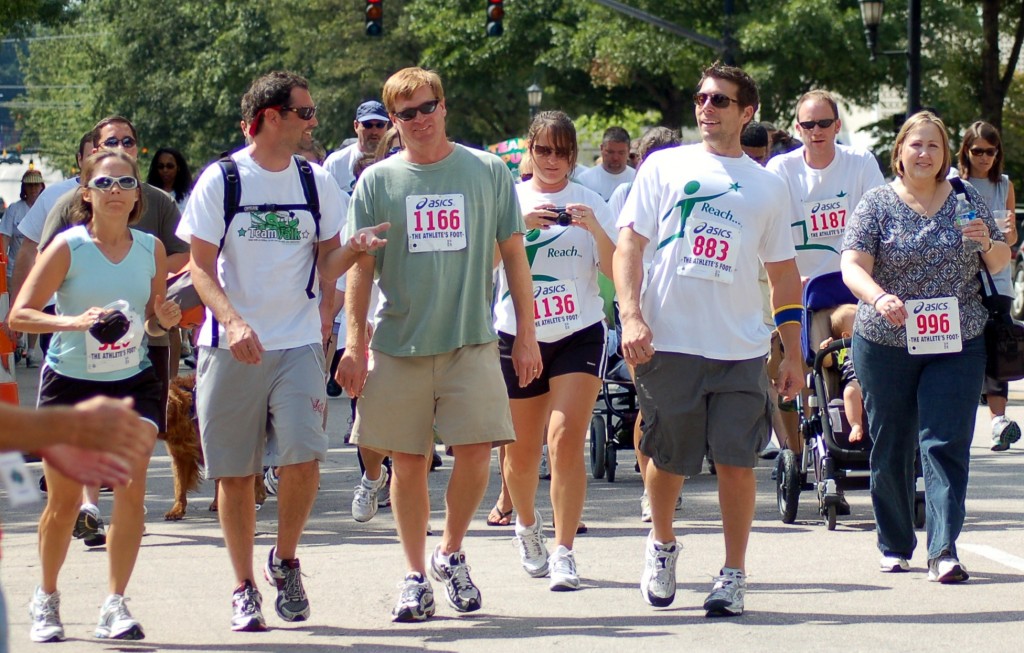
Do you get members from the ALS Chapter or from the Duke clinic you work with that come out?
We have! My doctor who is a neurologist at Duke and heads the ALS clinic where I go comes out and gives a great speech. And members of his team have come out and run the race too. This year we should have a good group of people from the ALS association staff who are planning to come out and even if they don't participate they cheer on all the competitors.
For those in a chair it can be hard and we are sensitive to this. We have had over the years people who have come out, not with a motor nueron disease like ALS or PLS, but I remember this one beautiful women who was maybe 10-years-old with Cerebral Palsy. She did one of the kids races with her walker and braces on and had this huge smile on her face. We had another young woman in her 20s who had been in this terrible car wreck years before. Her parents brought her out and she was so excited because there was this big event going on with people of all abilities and even in wheelchairs. Or sub-4 minute Milers like Tommy Schmitz who is coming out this year. For a couple of hours that day all the barriers are removed; everyone is doing one Mile. That was important for me when I was thinking about this years ago.
North Carolina has been a fantastic destination for the Mile, with the indoor Camel City Mile in Winston-Salem and the addition of the Sir Walter Miler just last month. But, putting on a road race is different from just hosting something on the track, even if it's just one Mile. It's often a labor of love that goes into putting on a race, but you've also managed to get some nice sponsorships and partnerships . What does that mean to the race?
 We're fortunate to have two great local sponsors, Quintiles and Lenovo, with headquarters here in Raleigh. They were the first two companies that we had and with their support we've been able to build the race. In the community it helps having two flagship companies on board to give your event validation and it helps bring in additional partnerships. The employees as well as their families come out to participate and it helps to have the financial support to put on a quality event. I think when our sponsors and partners come out, they love it. They love the experience of seeing elite athetes compete and at the same time do the recreational Mile with their kids. You have to try to get the sponsors intimately involved.
We're fortunate to have two great local sponsors, Quintiles and Lenovo, with headquarters here in Raleigh. They were the first two companies that we had and with their support we've been able to build the race. In the community it helps having two flagship companies on board to give your event validation and it helps bring in additional partnerships. The employees as well as their families come out to participate and it helps to have the financial support to put on a quality event. I think when our sponsors and partners come out, they love it. They love the experience of seeing elite athetes compete and at the same time do the recreational Mile with their kids. You have to try to get the sponsors intimately involved.
It's a tough balance on the financial side. How much do you charge registration fees, while being realistic about your costs. This year for instance we decided to forgo any print marketing materials and focused only on electronic messages. As a race director you have to keep revisiting what you do and ask, "do we really need this?" You have to review your event every year and not simply keep doing things because you've done them every year. Removing print marketing is saving us $10,000.
Has removing print marketing affected early registrations?
It seems like we are about where we were last year at this time. We have aggressively marketed it electronically and through our networks to make up for dropping print marketing.
Your race registration over the years suggests people have a great time, come back and bring friends. What do you think has made this event successful?
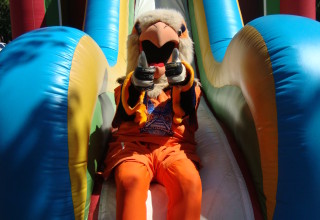 From personal experience I used to drag my husband and kids to races and they hated it (laughs). There was nothing to do for them and part of my thinking was to make this fun for families so that people can bring their kids. We started the Street Fair in 2007 and people really liked that!
From personal experience I used to drag my husband and kids to races and they hated it (laughs). There was nothing to do for them and part of my thinking was to make this fun for families so that people can bring their kids. We started the Street Fair in 2007 and people really liked that!
The Street Fair has been great to get other local organizations involved. We've had a Taekwondo school come out and do demonstrations in the hour before the race and people seem to really like that. A local gym comes out and leads the stretching about a half an hour before the race. We try different ways to tinker with the event. It's goofy things; we also have music and a DJ to make it more festive.
How many people does it take to put on the Magnificent Mile?
One thing we learned a few years ago is that it is easy to get volunteers for the day of the event, but it was much harder to get people to hang in there for the long term. We're lucky that we've been doing it for so long now that my husband and I do most of the prep work, such as the marketing and fundraising.
The last two years it was me personally doing it all myself and that was a little much. This year we spoke to the local timing company and they have been great handling a lot of the operational components like worrying about the port-a-potties or having tents for the registration area. It's a skeleton crew that puts on the race and I've also been lucky to have my church involved, which provides many of our volunteers.
Once you've put on a race for a few years, you begin to know the rhythm of it and pull in people when it is something you can't do yourself. Luckily a Mile cuts down on the logistical aspects unlike a 5K or a marathon. It allows you to focus more on the fun and not as much on water tables (laughs).
With the elite racers, you are working with the North Carolina USATF chapter. The Magnificent Mile also has North Carolina's road Mile records and the photos at the finish line look like people are out cheering like crazy. Why is it important to have elite's at these races and connect them with fans?
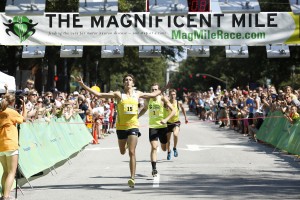 The way the course is setup, everyone from elites to the recreational runners have a great crowd. It's essentially a loop course. With the elites, it such a cool atmosphere. When the gun goes off it's almost like you just blink and they're already turning the corner heading down the homestretch. People are going absolutely nuts; it's almost surreal to see people running this fast. Our elite runners like it because often you run in obscurity. I have so much respect for these men and women and it's great to hear how much they enjoy the crowd being there. It goes both ways because the people in the crowd are equally excited. It's not too often you get to be that close to the action. It's also what I thought was so amazing about the Sir Walter Miler because people were right on the track watching people break 4 minutes or running under 4:40 for the women.
The way the course is setup, everyone from elites to the recreational runners have a great crowd. It's essentially a loop course. With the elites, it such a cool atmosphere. When the gun goes off it's almost like you just blink and they're already turning the corner heading down the homestretch. People are going absolutely nuts; it's almost surreal to see people running this fast. Our elite runners like it because often you run in obscurity. I have so much respect for these men and women and it's great to hear how much they enjoy the crowd being there. It goes both ways because the people in the crowd are equally excited. It's not too often you get to be that close to the action. It's also what I thought was so amazing about the Sir Walter Miler because people were right on the track watching people break 4 minutes or running under 4:40 for the women.
Sounds like Tommy Schmitz and Christy Cazzola who is also racing have their work cut out for them in chasing down the event and North Carolina road Mile records, 4:10 and 4:51 respectively.
What I hear from the athletes is that if you're just standing there look at the course it seems like a flat one. But, there is a tiny grade; just enough. When you head out there is a straigh quarter Mile and then maybe some jostling on the turn going by the capitol. You get some relief on the homestretch with a downhill straightaway. Last year the top three men finished within tenths of a second of each other! In the women's race, the winner broke away, but there was a clump of women duking it out for the second and third spots. I'm excited to see how it turns out this year!
Thank you Sarah and good luck this weekend.
Thanks!
